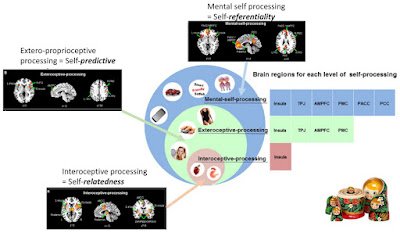"The self is the psychological counterpart of the default mode functionality of the brain." (Scalabrini et al., 2021).
The self studying how "The Self" is represented and constructed by the brain is apex meta-neuroscience.1 We can say that the self is a manifestation (or an illusory byproduct) of activity in the default mode network (medial prefrontal cortex, posterior cingulate cortex/precuneus, and angular gyrus), but what does this really mean? How do we relate specific neural states to aspects of a changeable self? In a field increasingly focused on remote control of genetically-defined microciruits, pinning down subjective internal phenomena seems presumptuous and hopelessly overambitious.
But of course, the inherent challenge of studying complex subjective experiences hasn't stopped scientists from trying. One active area of research involves characterizing the neural correlates of internal responses to traumatic events. This is of great clinical relevance, because the long-term persistence of fear, hypervigilance, negative affect, and intrusive memories after trauma can be disabling (post-traumatic stress disorder, PTSD). Alterations in one's sense of self (dissociation) can also occur in PTSD, and is the focus of the rest of this post. Dissociative symptoms can include:
- Depersonalization: Persistent or recurrent experiences of feeling detached from, and as if one were an outside observer of, one’s mental processes or body (e.g., feeling as though one were in a dream; feeling a sense of unreality of self or body or of time moving slowly).
- Derealization: Persistent or recurrent experiences of unreality of surroundings (e.g., the world around the individual is experienced as unreal, dreamlike, distant, or distorted).
In states of depersonalization/derealization (which can occur independently of PTSD), one feels disconnected from the self and/or external reality. Dissociative symptoms are considered a maladaptive (but protective) response to stress and trauma. The standard method of eliciting dissociative symptoms during fMRI scanning is script-driven imagery (SDI), a highly unpleasant manipulation. Before the experiment, the participant recounts a narrative of the traumatic event, which is subsequently read back to them in the scanner. The presence of acute dissociative symptoms is determined by questionnaires and interviews before, during, and after the scan.
Early studies reported increased activity in prefrontal (and other) cortical regions in the SDI condition compared to baseline (Lanius et al., 2002) or a neutral script condition (Hopper et al., 2007), which was related to the severity of dissociative symptoms. This fits a theoretical perspective where higher cortical regions are tamping down limbic (and emotional) responses to the trauma induction. It should be mentioned that dissociative responses to SDI are generally less common than vivid re-experiencing of the trauma (30% vs. 70% in Lanius et al., 2002). Drawbacks of these studies include small samples sizes and inconsistencies in the fMRI results.
Mertens and colleagues (2022) set out to replicate these findings in a larger, more homogeneous population of 51 female survivors of childhood abuse. The study included additional questionnaires and separation of the SDI condition into “script listening” and “focused recall” phases (previous studies only included the latter). The experimental design included three runs of neutral script (30 sec each of listening/imaging and focused recall of the event) and three runs of trauma script, which was effective in increasing self-reported ratings of dissociative symptoms, e.g. “Did what you were experiencing seem unreal to you, like you were in a dream or watching a movie or play?” and “Did you feel like you were a spectator watching what was happening to you, like an observer or outsider?” (rated on a 0-6 scale).
The fMRI results indicated that a wide swath of left cerebellum, occipital cortex, and supramarginal gyrus (parietal lobe) were more active in the trauma script than neutral condition, and this was specific to the script listening phase (no differences were observed during the focused recall phase). The same pattern was seen in the amygdala in a region of interest analysis. Importantly, there was no relationship between any of the clusters and any dissociation measure (amygdala and insula shown below).2
Fig. 2 (Mertens et al., 2022). Script-elicited signal activation clusters and corresponding brain-behaviour correlates (N = 51).
Footnotes
1 Self = a self-aware entity with fully-realized consciousness (whatever this means)
2 Here, the number of self-report and clinician-rated measures was impressive, e.g. Dissociative Experiences scale (trait dissociation), Cambridge Depersonalization Scale, Clinician Administered Dissociative States Scale, Responses to Script-Driven Imagery, etc.
Further Reading
Feeling Mighty Unreal: Derealization in Kleine-Levin Syndrome
A Detached Sense of Self Associated with Altered Neural Responses to Mirror Touch
Role of the Vestibular System in the Construction of Self
Derealization / Dying
'I Do Not Exist' - Pathological Loss of Self after a Buddhist Retreat
The Stranger in the Mirror
Writing-Induced Fugue State
References
Hopper JW, Frewen PA, van der Kolk BA,
Lanius RA. (2007). Neural correlates of reexperiencing, avoidance, and dissociation in PTSD: Symptom dimensions and emotion dysregulation in responses to script‐driven trauma imagery. Journal of Traumatic Stress 20(5):713-25.
Lanius RA, Williamson PC, Boksman K, Densmore M, Gupta M, Neufeld RW, Gati JS, Menon RS. (2002). Brain activation during script-driven imagery induced dissociative responses in PTSD: a functional magnetic resonance imaging investigation. Biological Psychiatry 52(4):305-11.
Lebois LA, Harnett NG, van Rooij SJ, Ely TD, Jovanovic T, Bruce SE, House SL, Ravichandran C, Dumornay NM, Finegold KE, Hill SB et al. (2022). Persistent dissociation and its neural correlates in predicting outcomes after trauma exposure. American Journal of Psychiatry Jun 22.
Mertens YL, Manthey A, Sierk A, Walter H, Daniels JK. (2022). Neural correlates of acute post-traumatic dissociation: a functional neuroimaging script-driven imagery study. BJPsych Open 8(4).
Northoff G, Scalabrini A. (2021). “Project for a Spatiotemporal Neuroscience”–Brain and Psyche Share Their Topography and Dynamic. Frontiers in Psychology 2021:4500.
Scalabrini A, Schimmenti A, De Amicis
M, Porcelli P, Benedetti F, Mucci C, Northoff G. (2022). The self and its internal thought: In search for a psychological baseline. Consciousness
and Cognition 97:103244.
Fig. 4 (Northoff & Scalabrini, 2021). Nested hierarchy of self in the brain.




No comments:
Post a Comment